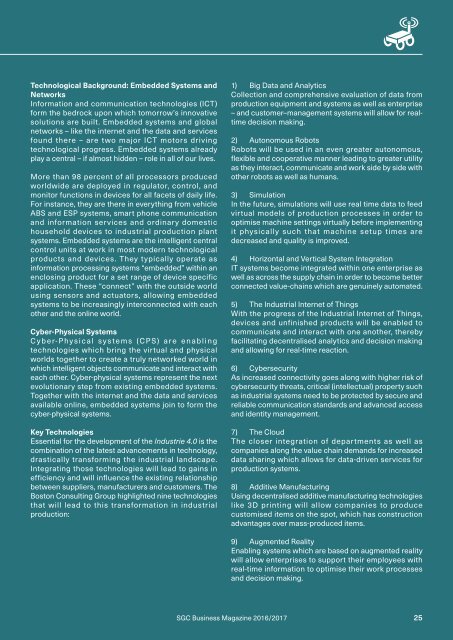SGC_issuu
Create successful ePaper yourself
Turn your PDF publications into a flip-book with our unique Google optimized e-Paper software.
Technological Background: Embedded Systems and<br />
Networks<br />
Information and communication technologies (ICT)<br />
form the bedrock upon which tomorrow’s innovative<br />
solutions are built. Embedded systems and global<br />
networks – like the internet and the data and services<br />
found there – are two major ICT motors driving<br />
technological progress. Embedded systems already<br />
play a central – if almost hidden – role in all of our lives.<br />
More than 98 percent of all processors produced<br />
worldwide are deployed in regulator, control, and<br />
monitor functions in devices for all facets of daily life.<br />
For instance, they are there in everything from vehicle<br />
ABS and ESP systems, smart phone communication<br />
and information services and ordinary domestic<br />
household devices to industrial production plant<br />
systems. Embedded systems are the intelligent central<br />
control units at work in most modern technological<br />
products and devices. They typically operate as<br />
information processing systems “embedded” within an<br />
enclosing product for a set range of device specific<br />
application. These “connect” with the outside world<br />
using sensors and actuators, allowing embedded<br />
systems to be increasingly interconnected with each<br />
other and the online world.<br />
Cyber-Physical Systems<br />
Cyber-Physical systems (CPS) are enabling<br />
technologies which bring the virtual and physical<br />
worlds together to create a truly networked world in<br />
which intelligent objects communicate and interact with<br />
each other. Cyber-physical systems represent the next<br />
evolutionary step from existing embedded systems.<br />
Together with the internet and the data and services<br />
available online, embedded systems join to form the<br />
cyber-physical systems.<br />
Key Technologies<br />
Essential for the development of the Industrie 4.0 is the<br />
combination of the latest advancements in technology,<br />
drastically transforming the industrial landscape.<br />
Integrating those technologies will lead to gains in<br />
efficiency and will influence the existing relationship<br />
between suppliers, manufacturers and customers. The<br />
Boston Consulting Group highlighted nine technologies<br />
that will lead to this transformation in industrial<br />
production:<br />
1) Big Data and Analytics<br />
Collection and comprehensive evaluation of data from<br />
production equipment and systems as well as enterprise<br />
– and customer–management systems will allow for realtime<br />
decision making.<br />
2) Autonomous Robots<br />
Robots will be used in an even greater autonomous,<br />
flexible and cooperative manner leading to greater utility<br />
as they interact, communicate and work side by side with<br />
other robots as well as humans.<br />
3) Simulation<br />
In the future, simulations will use real time data to feed<br />
virtual models of production processes in order to<br />
optimise machine settings virtually before implementing<br />
it physically such that machine setup times are<br />
decreased and quality is improved.<br />
4) Horizontal and Vertical System Integration<br />
IT systems become integrated within one enterprise as<br />
well as across the supply chain in order to become better<br />
connected value-chains which are genuinely automated.<br />
5) The Industrial Internet of Things<br />
With the progress of the Industrial Internet of Things,<br />
devices and unfinished products will be enabled to<br />
communicate and interact with one another, thereby<br />
facilitating decentralised analytics and decision making<br />
and allowing for real-time reaction.<br />
6) Cybersecurity<br />
As increased connectivity goes along with higher risk of<br />
cybersecurity threats, critical (intellectual) property such<br />
as industrial systems need to be protected by secure and<br />
reliable communication standards and advanced access<br />
and identity management.<br />
7) The Cloud<br />
The closer integration of departments as well as<br />
companies along the value chain demands for increased<br />
data sharing which allows for data-driven services for<br />
production systems.<br />
8) Additive Manufacturing<br />
Using decentralised additive manufacturing technologies<br />
like 3D printing will allow companies to produce<br />
customised items on the spot, which has construction<br />
advantages over mass-produced items.<br />
9) Augmented Reality<br />
Enabling systems which are based on augmented reality<br />
will allow enterprises to support their employees with<br />
real-time information to optimise their work processes<br />
and decision making.<br />
<strong>SGC</strong> Business Magazine 2016/2017<br />
25


